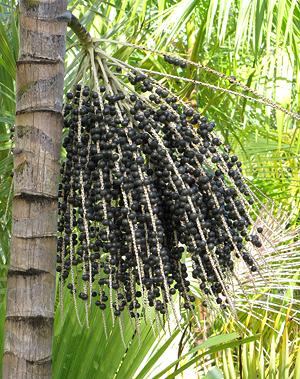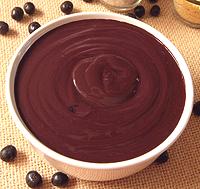 [Açaí Palm; Euterpe oleracea]
[Açaí Palm; Euterpe oleracea]
Pronounced "ah-sigh-EE". Açaí fruit has been harvested by indigenous peoples for thousands of years. Today it is a commercial crop in Brazil. The small purple fruit has thin skin and a thin layer of flesh over the seed, which constitutes about 75% of the fruit - but the trees are prolific. The black-purple fruits are small, up to about 3/4 inch (2 cm) diameter. The bunches (panicles) they grow on can contain 500 to 900 fruits.
In the early 2000s, there was panic buying by the "health conscious" for this "miracle fruit", resulting in rampant fraud and rip-offs perpetrated by "less than upright" sellers, more than for any other product. Fortunately, things have settled down quit a bit since then.
Beverages containing açaí juice and other products are still marketed through health food emporiums claiming high antioxidant content, anti-cancer activity, and miraculous curing of many diseases. The antioxidant content of these beverages is generally lower than in red wine or grape juice. The anti-cancer claims are still under study, but legitimate nutrition researchers seriously doubt them, as well as all the other "miracle fruit" claims made by the health food industry. While it still has the "healthy" image, its usage is becoming more normal. Photo by Forest and Kim Starr distributed under license Creative Commons Attribution Share-Alike v3.0 United States Attribution Required .
More on Palm Products.
 Açaí Bowls are the most popular use for Açaí in
North America. They consist of an Açaí smoothie made by blending
frozen Açaí pulp or powder with (usually) banana and yogurt.
They are normally topped with all varieties of fruits, nuts and seeds.
Açaí Bowls are the most popular use for Açaí in
North America. They consist of an Açaí smoothie made by blending
frozen Açaí pulp or powder with (usually) banana and yogurt.
They are normally topped with all varieties of fruits, nuts and seeds.
Açaí Bowls are also very popular in Brazil, usually made with banana, but not yogurt. Also in Brazil, pulp is used in sauces for fish, in faroufa crumbles, and in refreshing beverages.
The photo to the left is of a bowl of Açaí pulp without banana,
yogurt or toppings. Photo by MTur Destinos contributed to
the Public Domain.